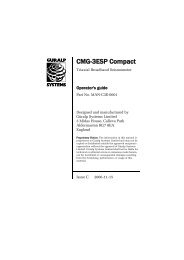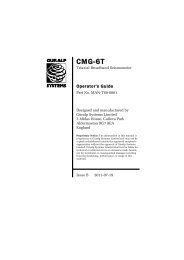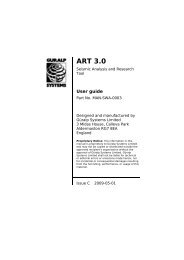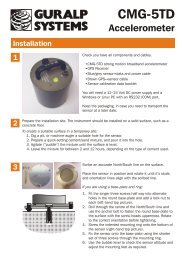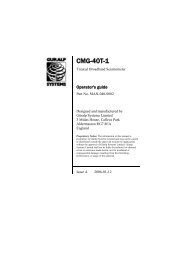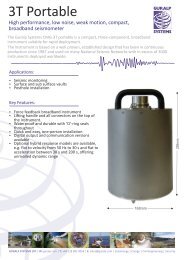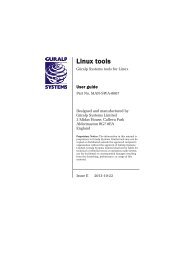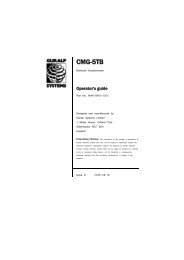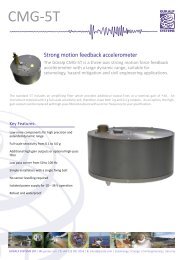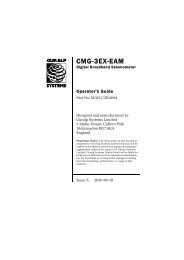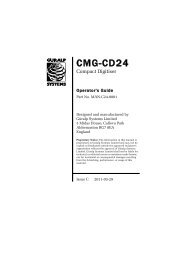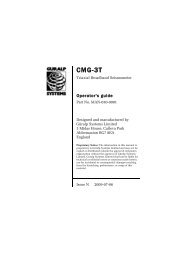MAN-040-0004 - CMG-40TDE Operator's Guide - Güralp Systems Ltd
MAN-040-0004 - CMG-40TDE Operator's Guide - Güralp Systems Ltd
MAN-040-0004 - CMG-40TDE Operator's Guide - Güralp Systems Ltd
You also want an ePaper? Increase the reach of your titles
YUMPU automatically turns print PDFs into web optimized ePapers that Google loves.
<strong>CMG</strong>-<strong>40TDE</strong><br />
Triaxial seismometer<br />
<strong>Operator's</strong> <strong>Guide</strong><br />
Part No. <strong>MAN</strong>-<strong>040</strong>-<strong>0004</strong><br />
Designed and manufactured by<br />
<strong>Güralp</strong> <strong>Systems</strong> Limited<br />
3 Midas House, Calleva Park<br />
Aldermaston RG7 8EA<br />
England<br />
Proprietary Notice: The information in this manual is<br />
proprietary to <strong>Güralp</strong> <strong>Systems</strong> Limited and may not be<br />
copied or distributed outside the approved recipient's<br />
organisation without the approval of <strong>Güralp</strong> <strong>Systems</strong><br />
Limited. <strong>Güralp</strong> <strong>Systems</strong> Limited shall not be liable for<br />
technical or editorial errors or omissions made herein,<br />
nor for incidental or consequential damages resulting<br />
from the furnishing, performance, or usage of this<br />
material.<br />
Issue A 2012-08-31
Table of Contents<br />
1 Introduction........................................................................................................................... 3<br />
1.1 Connections.................................................................................................................... 6<br />
1.1.1 DATA........................................................................................................................6<br />
1.1.2 NET........................................................................................................................... 7<br />
1.1.3 GPIO.......................................................................................................................... 7<br />
1.1.4 USB........................................................................................................................... 7<br />
1.1.5 GPS........................................................................................................................... 7<br />
2 Getting started....................................................................................................................... 8<br />
3 Understanding the manuals.................................................................................................9<br />
4 Connector pin-outs..............................................................................................................10<br />
4.1 DATA............................................................................................................................ 10<br />
4.2 NET............................................................................................................................... 11<br />
4.3 GPIO.............................................................................................................................. 12<br />
4.4 USB............................................................................................................................... 13<br />
4.5 GPS................................................................................................................................ 14<br />
5 Revision history................................................................................................................... 15
<strong>Operator's</strong> <strong>Guide</strong><br />
1 Introduction<br />
The <strong>CMG</strong>-<strong>40TDE</strong> seismometer is a three-axis, broad-band, forcefeedback<br />
seismometer packaged together with a 24-bit digitiser and a<br />
flexible data acquisition and storage unit, all in a single sealed case.<br />
The entire system is self- contained except for its power supply.<br />
The 40T system combines low-noise components with high feedback<br />
loop gain to provide a linear, precision transducer with a large<br />
dynamic range.<br />
August 2012 3
<strong>CMG</strong>-<strong>40TDE</strong><br />
The <strong>CMG</strong>-<strong>40TDE</strong> has a rugged, waterproof stainless steel design for<br />
ease of installation. The lightweight sensor elements are designed so<br />
that no mechanical clamping is required. Because of this, the 40T is<br />
ready to record ground movements as soon as you provide it with<br />
power. In addition, the sensor does not have to be levelled or centred<br />
as long as the base is within 3 ° of horizontal. For the best results,<br />
however, you should install where possible on a hard, near-horizontal<br />
surface well coupled to the bedrock.<br />
The <strong>CMG</strong>-<strong>40TDE</strong> consists of three internal modules, the 40T sensor, an<br />
integrated digitiser and an integrated data acquisition system<br />
4 Issue A
<strong>Operator's</strong> <strong>Guide</strong><br />
The integrated digitiser is a <strong>CMG</strong>-DM24, a low-noise, 24-bit ADC<br />
module specifically designed for seismic data. The built-in digital<br />
signal processor (DSP) provides simultaneous, multiple sample-rate<br />
data streams at user-selectable rates. Up to 6 streams of data for each<br />
component are available at sample rates from 1 to 1000 samples/s. A<br />
precision microprocessor-controlled time-base synchronizes the<br />
analogue-to-digital converters to the DSP and provides time-stamps for<br />
data. A separate microprocessor system handles configuration and<br />
sensor control, including mass centring and calibration.<br />
The integrated data acquisition system is a <strong>CMG</strong>-EAM,<br />
which provides serial and Ethernet communications, along with a<br />
convenient web-based interface to all functions, including digitiser<br />
and sensor configuration and control. It can act as a data recorder as<br />
well as a protocol converter and communications controller. Based<br />
around the powerful and stable Linux operating system, the <strong>CMG</strong>-<br />
EAM offers unrivalled flexibility, even including the ability to run<br />
user-installed scripts.<br />
Each instrument is delivered with a detailed calibration sheet showing<br />
its serial number, measured frequency response in both the long<br />
period and the short period sections of the seismic spectrum, sensor<br />
DC calibration levels, and the transfer function in poles/zeros notation.<br />
August 2012 5
<strong>CMG</strong>-<strong>40TDE</strong><br />
1.1 Connections<br />
The <strong>CMG</strong>-<strong>40TDE</strong> has five connectors on the top panel, the uses of<br />
which are described in this section.<br />
1.1.1 DATA<br />
The DATA port is the power input and also a general-purpose serial<br />
port. It is a command line terminal running at 115,200 Baud in the<br />
default configuration but it can also be used for GCF output (suitable<br />
for serial connection to Scream!) , PPP network connections, inbound<br />
GCF (from a digital instrument, for example), NMEA functions, TCP<br />
serial conversion, a modem answering service or as a recorder to store<br />
and forward data from any instrument with a serial output.<br />
6 Issue A
<strong>Operator's</strong> <strong>Guide</strong><br />
1.1.2 NET<br />
The NET port is a 100BASE-TX Ethernet connection. The supplied<br />
cable supports connection to a hub, switch or router. If direct<br />
connection to a PC or laptop is desired, an optional cross-over cable<br />
can be ordered.<br />
1.1.3 GPIO<br />
The GPIO (General Purpose Input/Output) port fulfils three functions:<br />
it provides a serial console to the EAM, which can be used for<br />
monitoring, configuration and control; it provides USB access from a<br />
PC or laptop to the internal FLASH storage for data collection (Use of<br />
this feature is described in the EAM manual, <strong>MAN</strong>-EAM-0001 ) and it<br />
provides a number of tri-state lines which can be used to control or<br />
monitor external equipment. One application is as tamper detection<br />
lines, which can be connected to external switches and monitors as<br />
part of a secure installation.<br />
1.1.4 USB<br />
The USB port allows connection of an external USB storage device for<br />
data collection. It is also possible to perform firmware upgrades using<br />
this port in situations where internet access is not available.<br />
1.1.5 GPS<br />
The GPS port allows connection of a GSL GPS receiver for use as a<br />
timing source for time-stamping seismic data. An additional serial<br />
port, ttySA2, is also available on this connector. It can be used for any<br />
of the functions listed above (in section 1.1.1).<br />
August 2012 7
<strong>CMG</strong>-<strong>40TDE</strong><br />
2 Getting started<br />
The <strong>CMG</strong>-<strong>40TDE</strong> accelerometer is preconfigured for terminal access at<br />
115,200 Baud from the DATA connector, to provide serial console<br />
access at 38,400 Baud via the GPIO connector and to configure its<br />
Ethernet interface (on the NET connector) using DHCP or APIPA.<br />
The easiest way to configure the <strong>CMG</strong>-<strong>40TDE</strong> is via the web interface<br />
so, if you have a DHCP server on your network, simply connect the<br />
provided network lead to the NET connector and apply 12VDC power<br />
via the supplied lead to the DATA connector. Allow the instrument<br />
thirty seconds to boot and then check the log of the DHCP server to<br />
ascertain the allocated IP address. You can then enter this into the<br />
address bar of your web browser (using http or https) and immediately<br />
access the status information and configuration interface.<br />
Alternatively, you can connect the <strong>CMG</strong>-<strong>40TDE</strong> via a network switch<br />
or network cross-over cable directly to a laptop or PC (some laptops<br />
and PCs automatically configure their network ports so that a crossover<br />
cable is not required). If your operating system supports APIPA<br />
(link-local addressing), both the <strong>CMG</strong>-<strong>40TDE</strong> and the computer will<br />
acquire automatic IP addresses. You can then determine the IP<br />
address of the <strong>CMG</strong>-<strong>40TDE</strong> by pinging the computer's broadcast<br />
address.<br />
If you have a network but cannot use DHCP or APIPA, you need to<br />
manually configure an IP address using a serial connection. Connect<br />
the provided network lead to the NET connector, 12VDC power via<br />
the supplied lead to the DATA connector, and a serial port on your PC<br />
to the GPIO connector. Start your terminal emulation software, such<br />
as HyperTerm or Minicom (configured for 38,400 Baud), and then<br />
follow the instructions in section 2.2.2 of the EAM manual to set a<br />
temporary IP address. You can then enter this into the address bar of<br />
your web browser (using HTTP or HTTPS) and immediately access the<br />
status information and configuration interface. You should set a<br />
permanent IP address at this point as the temporary address that you<br />
have just set will not persist after a reboot. See section 6.1 of the EAM<br />
manual for more details.<br />
If you do not have a network, you can still access the configuration<br />
interface using the serial console. Connect 12VDC power via the<br />
supplied lead to the DATA connector and a serial port on your PC to<br />
the GPIO connector. Start your terminal emulation software, such as<br />
HyperTerm or Minicom (configured for 38,400 Baud), and then follow<br />
the instructions in section 3.2 of the EAM manual.<br />
8 Issue A
<strong>Operator's</strong> <strong>Guide</strong><br />
3 Understanding the manuals<br />
The <strong>CMG</strong>-<strong>40TDE</strong> is a complex piece of equipment, the true flexibility<br />
of which can only be fully appreciated by studying the manuals. The<br />
instrument is covered by four separate documents:<br />
• <strong>MAN</strong>-<strong>040</strong>-<strong>0004</strong> - This document, which provides an overview, a<br />
getting-started guide and a list of other relevant manuals;<br />
• <strong>MAN</strong>-EAM-0003 - The <strong>CMG</strong>-EAM manual, which covers use of<br />
the data acquisition module, including configuration of the<br />
digitiser and control of the sensor. All of the instrument's external<br />
connectors are described in the <strong>CMG</strong>-EAM manual but, for<br />
convenience, this information is reproduced in section 4 of this<br />
manual.<br />
• <strong>MAN</strong>-<strong>040</strong>-0001 - The <strong>CMG</strong>-40T <strong>Operator's</strong> Manual, which<br />
describes the construction and operation of the sensor.<br />
• <strong>MAN</strong>-D24-<strong>0004</strong> - The <strong>CMG</strong>-DM24 digitiser manual, which<br />
describes the features of and command-line interaction with the<br />
digitiser. Note that, thanks to the EAM's convenient web and<br />
menu-based interfaces, direct use of the digitiser's command line<br />
is seldom necessary.<br />
August 2012 9
<strong>CMG</strong>-<strong>40TDE</strong><br />
4 Connector pin-outs<br />
4.1 DATA<br />
This is a standard 10-pin “mil-spec” plug,<br />
conforming to MIL-DTL-26482 (formerly<br />
MIL-C-26482). A typical part-number is<br />
02E-12-10P although the initial “02E” varies<br />
with manufacturer.<br />
Suitable mating connectors have partnumbers<br />
like ***-12-10S and are available<br />
from Amphenol, ITT Cannon and other<br />
manufacturers.<br />
The pin-out is the same as the serial output of a <strong>CMG</strong>-DM24 digitiser<br />
and any GSL digital instrument, allowing you to insert an instrument<br />
with an embedded <strong>CMG</strong>-EAM into a pre-existing installation and<br />
maintain connectivity.<br />
Pin Function<br />
A<br />
B<br />
C<br />
D<br />
E<br />
F<br />
G<br />
H<br />
J<br />
K<br />
Power input, 0 V<br />
Power input, +10 to +35 V<br />
RS232 CTS<br />
RS232 RTS<br />
RS232 DTR<br />
RS232 DSR<br />
RS232 ground<br />
RS232 CD<br />
RS232 receive<br />
RS232 transmit<br />
Wiring details for the compatible socket,<br />
***-12-10S, as seen from the cable end (i.e.<br />
during assembly).<br />
10 Issue A
<strong>Operator's</strong> <strong>Guide</strong><br />
4.2 NET<br />
This is a standard 6-pin “mil-spec” plug,<br />
conforming to MIL-DTL-26482 (formerly<br />
MIL-C-26482). A typical part-number is<br />
02E-10-06P although the initial “02E” varies<br />
with manufacturer.<br />
Suitable mating connectors have partnumbers<br />
like ***-10-06S and are available<br />
from Amphenol, ITT Cannon and other<br />
manufacturers.<br />
Pin Function<br />
A Ground<br />
B Data transmit +ve (RJ45 pin 1)<br />
C Data receive +ve (RJ45 pin 3)<br />
D External switched power output #0<br />
E Data receive –ve (RJ45 pin 6)<br />
F Data transmit –ve (RJ45 pin 2)<br />
Wiring details for the compatible socket,<br />
***-10-06S, as seen from the cable end (i.e.<br />
during assembly).<br />
August 2012 11
<strong>CMG</strong>-<strong>40TDE</strong><br />
4.3 GPIO<br />
This is a standard 12-pin “mil-spec” socket,<br />
conforming to MIL-DTL-26482 (formerly<br />
MIL-C-26482). A typical part-number is<br />
02E-14-12S although the initial “02E” varies<br />
with manufacturer.<br />
Suitable mating connectors have partnumbers<br />
like ***-14-12P and are available<br />
from Amphenol, ITT Cannon and other<br />
manufacturers.<br />
The USB lines provide external host access to the internal USB<br />
memory device. When power is sensed on pin J, an internal switch<br />
disconnects the memory device from the internal circuitry and<br />
connects it to this socket.<br />
Pin Function<br />
A<br />
B<br />
USB Data -ve (USB Type A pin 1) - see text above.<br />
USB Data +ve (USB Type A pin 3) - see text above.<br />
C Anti-tamper line 4<br />
D Anti-tamper line 3<br />
E Anti-tamper line 2<br />
F Anti-tamper line 1<br />
G<br />
H<br />
J<br />
Console transmit (RS232 TXD)<br />
Console receive (RS232 RXD)<br />
USB Power input (USB Type A pin 1) - see text above.<br />
K Ground (USB Type A pin 4)<br />
L Anti-tamper line 0<br />
M<br />
Ground<br />
Wiring details for the compatible plug,<br />
***-14-12P, as seen from the cable end (i.e.<br />
during assembly).<br />
12 Issue A
<strong>Operator's</strong> <strong>Guide</strong><br />
4.4 USB<br />
This is a standard 6-pin “mil-spec” socket,<br />
conforming to MIL-DTL-26482 (formerly<br />
MIL-C-26482). A typical part-number is<br />
02E-10-06S although the initial “02E” varies<br />
with manufacturer.<br />
Suitable mating connectors have partnumbers<br />
like ***-10-06P and are available<br />
from Amphenol, ITT Cannon and other<br />
manufacturers.<br />
Pin Function<br />
A +5 V DC (USB Type A pin 1)<br />
B Data –ve (USB Type A pin 2)<br />
C Data +ve (USB Type A pin 3)<br />
D 0 V (USB Type A pin 4)<br />
E Shielding<br />
F not connected<br />
Wiring details for the compatible plug,<br />
***-10-06P, as seen from the cable end (i.e.<br />
during assembly).<br />
August 2012 13
<strong>CMG</strong>-<strong>40TDE</strong><br />
4.5 GPS<br />
This is a standard 10-pin “mil-spec” plug,<br />
conforming to MIL-DTL-26482 (formerly<br />
MIL-C-26482). A typical part-number is<br />
02E-12-10P although the initial “02E” varies<br />
with manufacturer.<br />
Suitable mating connectors have partnumbers<br />
like ***-12-10S and are available<br />
from Amphenol, ITT Cannon and other<br />
manufacturers.<br />
This pin-out is the same as the GPS input of a DM24 digitizer.<br />
Pin Function<br />
A<br />
B<br />
C<br />
D<br />
E<br />
F<br />
G<br />
H<br />
J<br />
K<br />
Power 0 V<br />
Power +12 V<br />
1pps signal<br />
not connected<br />
Serial port (ttySA2) TxD<br />
Serial port (ttySA2) RxD<br />
RS232 ground<br />
Serial port (ttySA2) ground<br />
RS232 transmit to GPS<br />
RS232 receive from GPS<br />
Wiring details for the compatible socket,<br />
***-12-10S, as seen from the cable end (i.e.<br />
during assembly).<br />
14 Issue A
<strong>Operator's</strong> <strong>Guide</strong><br />
5 Revision history<br />
2012-08-31 A New document<br />
August 2012 15





